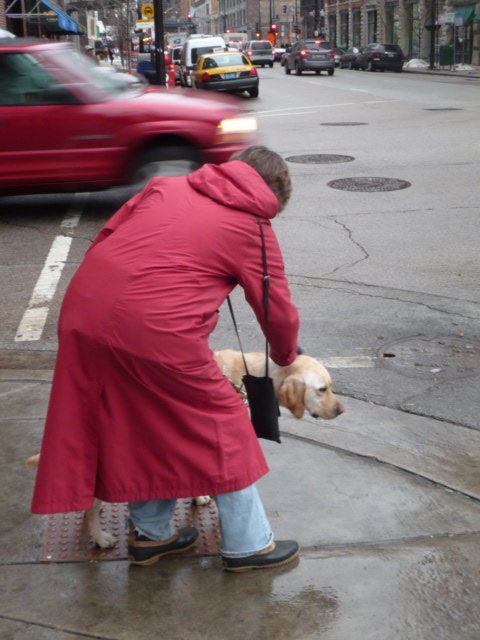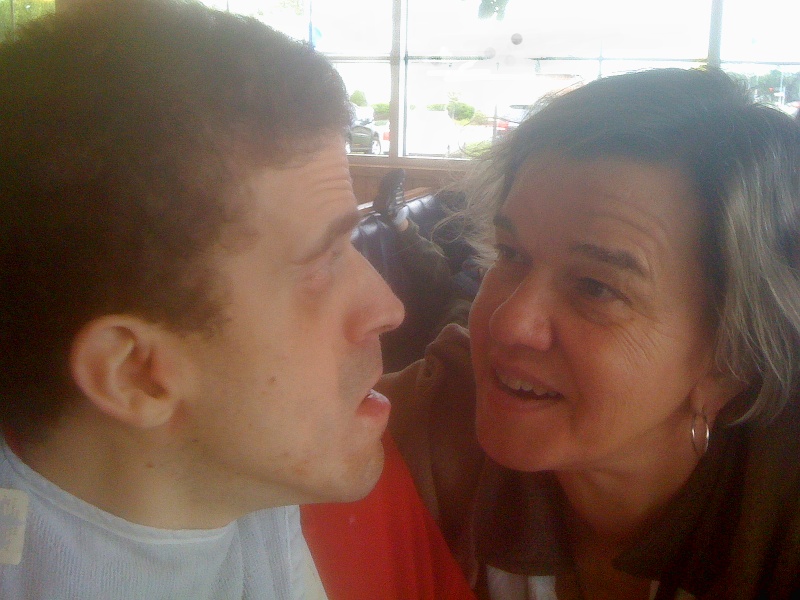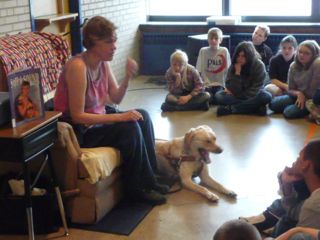A lot of you have been asking about Harper’s progress after that home visit from a Seeing Eye instructor last month. How about I start with some details about that visit?

The refresher course is working--Harper's starting to work the corners just right.
Nicole flew in from Morristown on Monday, April 24 and spent that first afternoon observing my work with Harper. He did not hold back. In one short walk, Harper refused to go all the way to the corner at an intersection, he veered right when we crossed, and then wouldn’t follow my command to turn right so we could take a walk to the park. He did get me home, though and over a cup of tea Nicole assured me I hadn’t done anything wrong to cause Harper’s behavior. “We’ve just gotta work on how you react when he behaves like this,” she said.
I’d been talking sweetly to Harper when he cowered down on the sidewalk. “C’mon, Harper, it’s okay,” I’d coo, telling him he didn’t have to be scared, then urging him to get up and continue working. My sweet-talk rewarded Harper for his bad behavior. Not good. And when he veered during street crossings, I’d pull back on the harness, which only made him want to pull harder the wrong way. Nicole assured me that Harper wants to do the right thing. When he isn’t sure what the right thing is, though, he cowers. “You need to tell him what you want from him,” she said. “And you need to say it like you mean it!”
She pointed out another problem, too. Harper loves to retrace his steps. “I’ve never seen a dog with such a strong homing instinct!” Nicole told me. One of the many, many reasons dogs have been selected to guide people who are blind is that strong canine homing instinct. Harper’s determination to retrace his steps, however, is a bit extreme. Example: We’ve visited my doctor at his office on Michigan Avenue once. Just once. Now Harper drags me to that building any time we get near it.
I like my doctor and all, but there are other places I like to visit on Michigan Avenue. When Harper veered towards the building, I’d say a gentle “no” and command “forward.” Harper would cower, then plant himself on the sidewalk. We were going into that doctor’s office, or nowhere at all.
Some of Nicole’s suggestions to remedy Harper’s behavior were simple. When Harper veers left at the doctor’s office, I keep my arm at my side, drop the harness and keep my body facing forward. Harper’s leash is looped around my wrist. If I keep my arm stiff when he veers towards the building, he is naturally jerked back to my side. I pick up the harness again, command “forward!” He may test this a few times, but once Harper realizes I really do know where I want to go, he leads me forward. Good boy, Harper!
Other suggestions were a bit more complicated. Clicker training, for example. Award-winning Seeing Eye instructor Lukas Franck taught us clicker training while we were in Morristown last December, and I’ve used it at home to teach Harper to find the elevator button in our hallway. When Nicole was here she taught me how to use the clicker method out on the street, too.
For the past couple weeks I’ve been clicking the clicker every time Harper gets me to the end of a block. He understands that the click means “you got it!” and he knows that the sound of the click means he gets a small treat. Harper hardly ever cowers anymore, he’s in such a rush to get to the end of the block to collect his reward! He’s also learned that he doesn’t hear the click if he tries to turn left or right before we get to the end of the block. I don’t click the clicker until I can feel the curb or curb cut with my feet. The lack of a click tells Harper that he has to adjust position to hear his click. Then, and only then, does he get his food reward. From the clicker training web site:
Traditional guide dog training utilizes praise to inform the dog of what behavior we want them to continue to perform. It relies on using a verbal word or phrase (“Good dog!”, “Atta boy”) immediately when the dog performs in order to tell the dog it has done well. Although this clearly works, it is not nearly as precise as communicating with an audible event marker like a clicker. The clicker’s sound has meaning to the dog because the trainer first conditions the dog to expect high value reward following the sound of the click.
Giving Harper a treat to reward him for getting to the curb goes directly against what I’d learned when training with my previous Seeing Eye dogs Pandora and Hanni. Back then we were strongly discouraged from rewarding our dogs with food. Heap on the praise instead, they told us. Guide dogs are allowed in restaurants, amusement parks, receptions, food courts, you name it. They have to be able to keep on task without being distracted by food.
Lukas — and then Nicole — assured me that the Seeing Eye had tested the clicker training method extensively. I could use treats as rewards and still expect Harper to ignore food distractions in restaurants and the like.
And you know what? It’s working. Harper’s work is not perfect – well, not yet, at least — But it has really, really improved. This week I’ve started weaning him off the clicker; IOW, I don’t click at each and every curb anymore. So far he’s still getting me to the end of each block without cowering, and his tail wags with pride when he does. Atta boy, Harper. Good boy!




